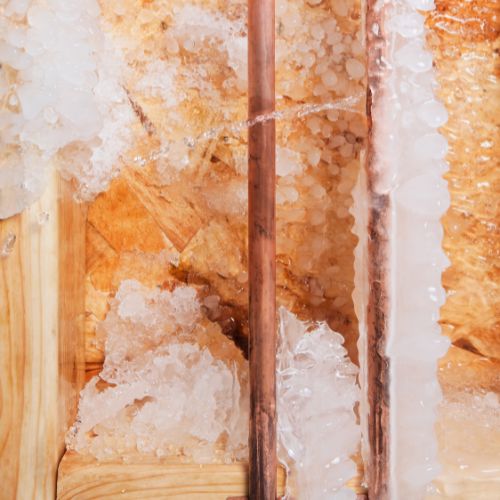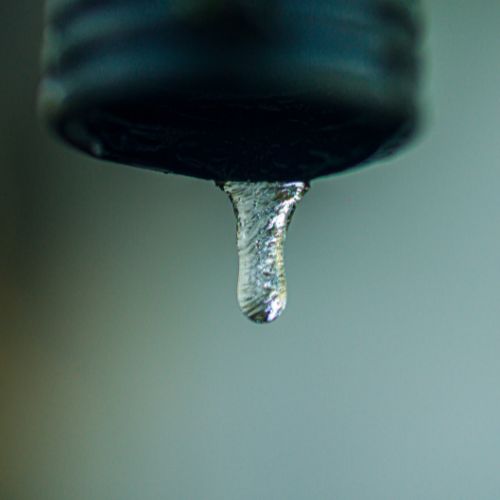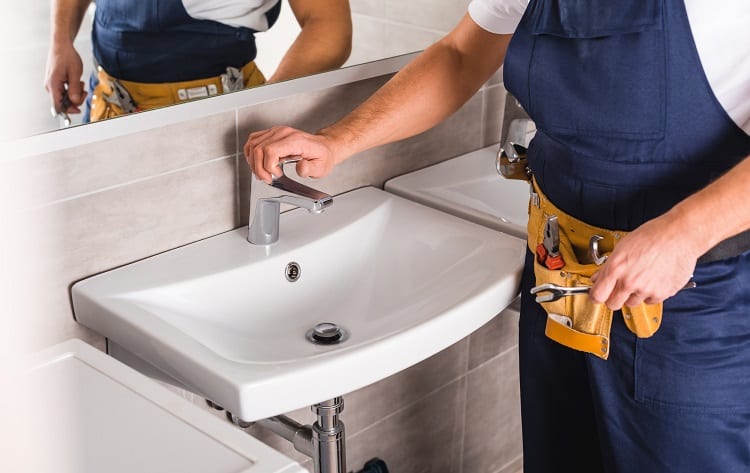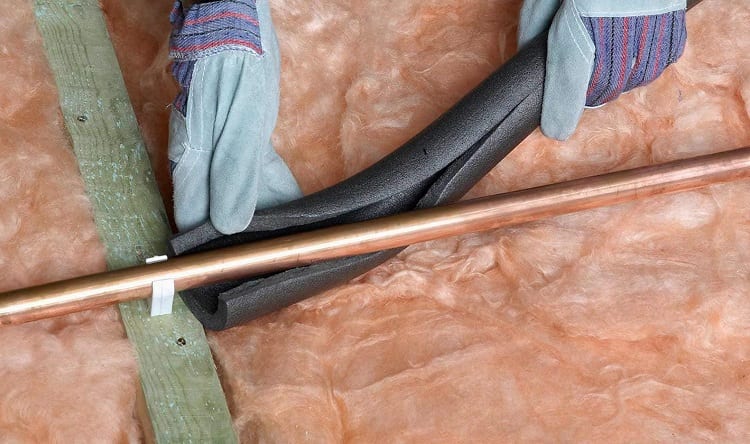If you’ve ever experienced frozen bathroom pipes, you know how frustrating it can be. Not only does it prevent you from using your bathroom, but it can also lead to burst pipes and costly repairs. Fortunately, there are steps you can take to safely and effectively thaw frozen bathroom pipes.
Let’s dive in and take a look at how to unfreeze pipes in your bathroom, and prevent frozen pipes in the future.
Table of Contents
How to Find a Frozen Pipe
Winter hits particularly hard in the northern states and sub-zero temperature can cause all sorts of problems for the residents, including being barricaded inside their own homes, slick roads, and of course, frozen pipes.
Before attempting to thaw the pipes, it’s important to identify which pipes are frozen. Signs of frozen pipes include:
- A lack of water flow
- Low water pressure
- Frost on the pipe
- Strange noises in the pipes
You might have all of these signs, or only one or two. Once you’ve identified the frozen pipes, it’s time to start thawing them.
One of the safest and most effective ways to thaw frozen bathroom pipes is by using a hair dryer or heat lamp. Aim the heat source at the frozen section of the pipe and move it back and forth until the water starts to flow again.
It’s important to keep the heat source moving to avoid damaging the pipe. Avoid using an open flame or other high heat source, as this can be dangerous and cause damage to your pipes.
How to Thaw Frozen Bathroom Pipes

Toilet Pipes
- Locate the Frozen Section: Feel along the pipes to find the coldest spot. This is likely where the freeze is.
- Apply Heat: Use a hair dryer, heat lamp, or portable heater to apply heat to the frozen section. Move the heat source back and forth along the pipe, not just on one spot.
- Open the Faucet: Turn on the toilet’s flush slightly to allow water to flow. This helps melt the ice and relieves pressure in the pipe.
- Insulate the Pipes: Once thawed, wrap the pipes in foam insulation to prevent future freezing.
Toilet Tank
- Warm the Room: Increase the room temperature with a portable heater. The ambient heat will gradually thaw the tank.
- Apply an Electric Blanket or Heated Throw: A heated throw rug can work wonders draped over a toilet tank. The gentle heat will help melt the ice.
- Avoid Direct Heat: Don’t use direct heat sources like blow torches as they can damage the tank.
Toilet Supply Line
- Access the Line: If possible, access the toilet supply line (usually running from the floor or wall to the bottom of the tank).
- Apply Heat: Use a hair dryer or heat lamp to warm the supply line. Keep the heat moving along the line.
- Check for Leaks: Once thawed, check for any leaks or damage.
Toilet Bowl
- Pour Warm Water: If you’ve got any warm water in the kettle, or can access warm water from other taps in your home, slowly pour warm (not boiling) water into the bowl. This can help melt the ice.
- Apply Heat: Use a space heater to warm the area around the toilet. Keep it at a safe distance to avoid any hazards.
- Check for Blockages: After thawing, flush to ensure there are no blockages caused by the freeze.
Sink Pipe
- Open Cabinet Doors: Open the doors under the sink to allow warmer air to circulate around the pipes.
- Apply Heat: Use a hair dryer or portable heater to apply heat to the frozen section of the pipe.
- Turn on the Faucet: Open the faucet to allow water to drip out. This helps in melting the ice and reduces pressure.
- Insulate After Thawing: Once thawed, consider insulating these pipes to prevent future freezes.
Bathroom Vent Pipe
- Locate the Vent: Find the bathroom vent pipe, usually exiting through the roof.
- Apply External Heat: If accessible, use a heat gun or hair dryer to apply heat around the vent pipe’s exterior. Be cautious when using ladders or working on the roof.
- Increase Internal Temperature: Inside the bathroom, use a portable heater to raise the room’s temperature, aiding in thawing the vent pipe from within.
- Check for Blockages: Once thawed, ensure the vent is clear of any debris that could cause future blockages.
Cold Water Pipe
- Identify the Frozen Section: Feel along the cold water pipes to locate the frozen area, which will feel significantly colder.
- Open the Faucet: Turn on the faucet connected to the frozen pipe. This helps relieve pressure and allows water to flow once it starts to thaw.
- Apply Heat: Use a hair dryer, heat lamp, or electric heating pad to gradually warm the frozen section. Move the heat source along the pipe evenly.
- Insulate Pipes: After thawing, insulate the pipes to prevent refreezing.
Shower Pipes
Frozen shower pipes are difficult to access as they are in behind the wall. You can try warming the bathroom as a whole, with time, they will eventually defrost.
Don’t put any appliances in the shower, this is an electrical hazard when the pipes unfreeze.
- Turn on Shower: Slightly turn on the shower to allow water to trickle out as the ice melts.
- Insulate After Thawing: Once the pipes are thawed, wrap them in foam insulation to prevent future freezing.
Safety Tips
- Always prioritize safety, especially when working at heights or with electrical appliances near water.
- Avoid using open flames, such as propane torches, as they pose a significant fire and melting hazard.
- If you’re unable to safely access or thaw the pipes, or if you suspect damage, it’s best to call a professional plumber.
- After thawing, check for leaks since frozen pipes can sometimes crack or burst.
Frequently Asked Questions

What Temperature Do Pipes Freeze At?
Pipes can freeze when the temperature drops below 32°F (0°C). The temperature at which pipes freeze depends on insulation, wind chill, and the length of time the temperature remains below freezing.
What Happens if Your Pipes Freeze?
If your pipes freeze, the water inside them expands and can cause the pipes to burst. This can lead to water damage and costly repairs.
Should I Turn Off Water if Pipes are Frozen?
Yes, you should turn off the water supply if you suspect that your pipes are frozen. This will help prevent any further damage to your plumbing system.
Can I use a hairdryer to thaw my bathroom pipes?
Yes, you can use a hairdryer to thaw your bathroom pipes. Use the hairdryer on the lowest heat setting and to keep it at a safe distance from the pipes to avoid any damage.
Is it safe to use hot water to thaw frozen pipes?
No, it is not safe to use hot water to thaw frozen pipes. Hot water can cause the pipes to expand too quickly and potentially burst. Use a hairdryer or space heater to thaw the pipes slowly and safely.
Should I call a plumber to thaw my frozen bathroom pipes?
If you are uncomfortable or unsure about thawing your frozen bathroom pipes yourself, call a plumber. A professional plumber can safely and effectively thaw your pipes and prevent any further damage to your plumbing system. They can help you with insulating your pipes to reduce the likeliness of freezing in the future.
How Long Does it Take for Pipes to Unfreeze?
Pipes may naturally unfreeze or defrost within several hours. This depends on your ambient temperature, the thickness of the pipe and how large of an area is frozen.
How to Stop Pipes Freezing in an Empty House
If you are going to be away from your home for an extended period of time during the winter, it is important to take precautions to prevent your bathroom pipes from freezing.
Here are some steps you can take to keep your bathroom pipes from freezing in an empty house:
- Insulate your pipes: Insulating your bathroom pipes can help to keep them from freezing. You can use foam pipe insulation or heat tape to insulate your pipes. Make sure to insulate all exposed pipes, including those in your basement or crawl space.
- Keep your heat on: It is important to keep your heat on even when you are away from home. Set your thermostat to at least 55 degrees Fahrenheit to prevent your pipes from freezing. If you have a programmable thermostat, you can set it to turn on the heat for a short period of time each day to save energy.
- Open cabinet doors: If you have bathroom cabinets that are located on an exterior wall, open the doors to allow warm air to circulate around the pipes. This can help to prevent them from freezing.
- Shut off your water supply: If you are going to be away from home for an extended period of time, you may want to consider shutting off your water supply. This will prevent water from flowing through your pipes and potentially freezing.
- Hire a plumber: If you are unsure about how to prevent your bathroom pipes from freezing, it may be a good idea to hire a plumber. A plumber can inspect your pipes and recommend the best course of action to prevent them from freezing.
How to Know If Your Bathroom Pipes are Frozen

Here are some signs that could mean your bathroom pipes are frozen:
- Your Faucets Won’t Flow: If you turn on the faucet in your washbasin and only a trickle comes out —or no water at all — it may be because your bathroom pipes are frozen.
- Toilets Won’t Flush: If there is no water in your toilet bowl or your toilet won’t release a waterfall when you flush it, it is a good sign that your bathroom pipes have frozen.
- Bulging Water Line: A bulging water line can indicate that water has expanded and frozen into ice. These lines may also be more prone to breaking, so inspect them to see any cracks. They may also be coated in frost. Some pipes like the ones under you sink can be easily seen and if you see frost on them, this is a sign that the water in the pipe has frozen.
- Strange Smells: Another sign of a frozen pipe can be bad odors coming from the drain. Once the water in your bathroom pipe freezes, the pipe becomes blocked and the odors do not have any other way to go than back up.
What to Do if a Pipe Bursts
When water freezes, it expands and can burst your pipe.
When this happens, you need to act very quickly to save your property from the inevitable flood that will wreck your property.
According to the Insurance Institute for Business and Home Safety, property damage from bursting pipes can cause homeowners an average of $5,000.
So if you walk into your basement to find a geyser has erupted inside your house, the first thing you should do to mitigate the damage is to quickly shut off the main water supply.
This will cut off the water supply to your whole house.
Bear in mind though that all the plumbing fixtures in your house usually come equipped with their own individual shut off valve that will shut off water supply to only that fixture.
So if you know that the problem stems from a single pipe, you do not need to shut off water to the whole house. You can just turn off the valve for that pipe.
However, this method only works if you are only working on pipes that the valve shuts off.
Some pipes in your home may not have a shut-off valve at all, so you may need to turn off the valve to the main water supply.
Once you have shut off the appropriate valve, call the plumber to your house.
Quickly remove as much water as you possibly can using mops, wipers, sponges, towels, and wet vacuum.
To make sure there is no danger of mildew and mold, run a fan or heater until then place is completely dry.
Fortunately, your homeowner insurance will likely cover the cost of water damage.
How to Prevent Bathroom Pipes From Freezing

When it comes to bathroom pipes, being proactive is important.
Some of the tips recommended in this section may go against your eco-friendly instincts, and they may get you a bigger energy bill, however, the cost will be nothing compared to a huge repair bill.
- Insulate Your Pipes: According to the IBHS, pipe insulation costs you as little as 50 cents for every foot of pipe. You can use this insulation to cover up your pipes and prevent any future headaches in the from of lost valuables and damaged property.
- Close your Garage Doors: Keep your garage doors closed at all times, especially if you have pipes running through it. This will prevent them from freezing.
- Open the Bathroom Cabinet Doors: Open your bathroom cabinet doors so that the heated air form the bathroom can also warm your plumbing, especially if your sinks have pipes connected to the exterior wall.
- Leave the Water Running: Turn on your faucet a little bit and let the water trickle through. Although it may be against your water conservation values, a small trickle can keep the water running and hence prevent water in the pipes from freezing.
- Flush the Toilet: Flush your toilet every now and then so that your water tanks keep filling, allowing your pipe to stay thawed out. If the toilet line is frozen, isolate it from the other water lines so that the cold vapors from the line do not freeze them as well.
- Turn up the Heat: Turn up the heat in your house as much as you can comfortably stand it. Keep the heating on to at least 55 degree Fahrenheit when you leave your home for school or work so that the pipes stay thawed out. This may result in a higher energy bill but not as much as you will have to pay when your pipes burst.
- Insulate Cold Places: Add insulation to your attic, basement, garage and crawl places. This will do wonders to maintain a high temperature in those spaces. Also caulk all the cracks in your windows, doors, and vents so that cold drafts cannot enter your home.
If you’d like to see a graphical breakdown of ways to prevent bathroom pipes from freezing, we got you covered:

Share this Image On Your Site
<p><strong>Please include attribution to Bomisch.com with this graphic.</strong><br /><br /><a href=’https://www.bomisch.com/frozen-bathrooms-pipes/’><img src=’https://www.bomisch.com/wp-content/uploads/2020/03/Prevent-Pipes-Freezing.jpg’ alt=’Prevent Pipes Freezing’ width=’780px’ border=’0′ /></a></p>
Bottom Line
If you live in areas where winter always brings frost, you should know that your bathroom pipes are especially vulnerable.
With just a little precaution, you can prevent ice from forming in your pipes and breaking them.
If your pipes become frozen anyway, no need to panic. Just follow the tips above and everything will turn out fine.
